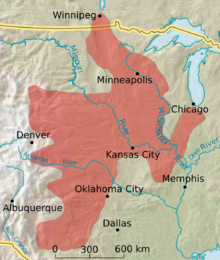Lowland pocket rat
| Lowland pocket rat | ||||||||||||
|---|---|---|---|---|---|---|---|---|---|---|---|---|

Lowland pocket rat ( Geomys bursarius ) |
||||||||||||
| Systematics | ||||||||||||
|
||||||||||||
| Scientific name | ||||||||||||
| Geomys bursarius | ||||||||||||
| ( Shaw , 1800) |
The lowland pocket rat or Louisiana pocket rat ( Geomys bursarius ) is native to the prairie areas of North America and is one of 40 species in the family of pocket rats (Geomyidae). The pocket rats belong to the rodent order and were named after their outer, fur-covered pocket cheeks.
description
The lowland pocket rat has short, light brown to black fur; the fur is usually lighter on the belly. White hair covers the feet, the tail is almost bare. As an adaptation to the burrowing way of life, the eyes are small, the auricles are short and bare and there are large digging claws on the front feet. The zygomatic arch is expanded to provide sufficient space for the muscle-masseter - approach to give, as the front teeth are also used for digging. The lips close behind these teeth so that sand and dirt do not get in when digging. The external cheek pockets are used to transport food and can be turned inside out for cleaning purposes.
On average, the lowland pocket rat has a total length of 236 mm, of which the tail has a share of 65 mm. The male lowland pocket rat weighs 180 to 200 g, the female 120 to 160 g.
distribution

Lowland pocket rats are native to the Great Plains , the area stretching between southern Manitoba , eastern North Dakota , New Mexico and Texas, and western Indiana .
Way of life
The lowland pocket rat prefers deep, sandy and fragile soil in open spaces and moderately forested areas. This corresponds to the digging and root-eating way of life. The extensive tunnel systems are up to 100 and 150 meters long, the main tunnel has a depth of 15 to 23 cm with side tunnels 20 to 45 cm in length that lead to feed chambers, cesspools, the central nest or the surface. Much of the burial activity is for foraging. Tunnel construction mainly takes place in spring and autumn. The animals are active all day long, with activity peaks at dusk and at night. The rodents are solitary animals and defend their territory aggressively against other lowland pocket rats. Except for the mating season in spring, the animals rarely leave their den.
The lowland pocket rat becomes sexually mature at 12 months. The litter ranges in size from one to six pups, which are usually born between March and May after four weeks of gestation . The young animals are raised by the mother and leave the den after two months of weaning.
The lowland pocket rat covers most of its water needs with its food.
Subspecies
The phylogenetic relationships within the genus Geomys are complex and not fully established. For example, Geomys knoxjonesi was originally regarded as a subspecies of the lowland pocket rat. As of 2016, eight subspecies of the lowland pocket rat have been described, these are:
- Geomys bursarius bursarius Shaw, 1800
- Geomys bursarius illinoensis Komarek & Spencer, 1931
- Geomys bursarius industrius Villa & Hall, 1947
- Geomys bursarius major Davis, 1940
- Geomys bursarius majusculus Swenk, 1939
- Geomys bursarius missouriensis McLaughlin, 1958
- Geomys bursarius ozarkensis Elrod, Zimmerman, Sudman & Heidt, 2000
- Geomys bursarius wisconsinensis Jackson, 1957
Danger
The IUCN classifies the lowland pocket rat as not endangered . Due to its wide distribution and adaptability to habitats, the lack of major threats and an apparently stable population, the lowland pocket rat is not endangered.
Individual evidence
- ↑ Geomyidae. ( Memento of the original from June 3, 2010 in the Internet Archive ) Info: The archive link was inserted automatically and has not yet been checked. Please check the original and archive link according to the instructions and then remove this notice. In: Don E. Wilson , DeeAnn M. Reeder (Eds.): Mammal Species of the World. A Taxonomic and Geographic Reference. 2 volumes. 3. Edition. Johns Hopkins University Press, Baltimore MD 2005, ISBN 0-8018-8221-4 . Retrieved March 14, 2010.
- ^ Society papers . Transactions of the Linnean Society. Vol. V. London, J. Davies. 1800, 269, 6 p. 4. In: Archives for Zoology and Zootomy. Vol. 3, Piece 1, 1802, ZDB -ID 525797-9 , pp. 230-247, here pp. 242-243 .
- ↑ a b c d e Kate Teeter: Geomys Bursarius , Animal Diversity Web, 2007, accessed January 11, 2010
- ↑ a b c d David J. Schmidly: The Mammals of Texas (= The Corrie Herring Hooks Series. Vol. 59). Revised edition. University of Texas Press, Austin TX 2004, ISBN 0-292-70241-8 .
- ↑ a b c d e f g h Charles W. Schwartz, Elizabeth R. Schwartz: The Wild Mammals of Missouri . 2nd revised edition. University of Missouri Press, Columbia MO 2001, ISBN 0-8262-1359-6 .
- ↑ Ronald M. Nowak: Walker's Mammals of the World. 2 volumes. 6th edition. Johns Hopkins University Press, Baltimore MD et al. 1999, ISBN 0-8018-5789-9 .
- ↑ a b c d e A. V. Linzey, G. Hammerson: Geomys bursarius. IUCN Red List of Threatened Species, 2008, accessed January 10, 2010.
- ↑ Mark Hafner: Family Geomyidae (Pocket gophers). In: Don Ellis Wilson and Russell A. Mittermeier (Eds.): Handbook of the Mammals of the World. Volume 6: Lagomorphs and Rodents 1 Lynx Edicions, Barcelona 2016, ISBN 978-84-941892-3-4 , pp. 257-261
Web links
- Pictures and description of Geomys bursarius in Mammals of Kansas